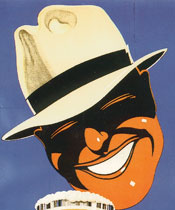New research into Britain’s drinking habits finds “Beer is the drink of style and sophistication.”
We might as well get the grain-of-salt stuff out of the way first. This research was commissioned by the British Guild of Beer Writers, who have good reason to suggest that newspapers run more stories about beer. And Pete Brown, author of two popular books about beer, founded Storm Lantern, the consulting firm that did the research.
 So you are entitled to think this carries the same sort of authority as the recent report funded by MySpace that found MySpace is a great marketing platform. Personally, I favor giving credit to the guild for trying to change the image of beer (sound familiar?) and to think that similar research in the United States would show that there’s a good-sized market for stories of a beery nature.
So you are entitled to think this carries the same sort of authority as the recent report funded by MySpace that found MySpace is a great marketing platform. Personally, I favor giving credit to the guild for trying to change the image of beer (sound familiar?) and to think that similar research in the United States would show that there’s a good-sized market for stories of a beery nature.
Speaking for the report, Brown said: “This research proves emphatically that having an enthusiastic appreciation of beer is mainstream – most of the people drinking specialty beers and real ales do so not because they’re beer geeks, but because they are more discerning about all food and drink.”
The report found:
– There are over seven million “beer fans” in the UK – “people who drink beer, but also drink a wide variety of beer styles (i.e. not just lager), seek out new beers and are prepared to pay more for quality.”
– Beer enthusiasts are young, upmarket, affluent and well-educated (55% aged 18-44).
– They are mainly male (but still include half a million women).
– They are voracious readers of quality newspapers and magazines, very interested in news and current affairs, travel sections, anything to do with new cars and gadgets.
– They are bon viveurs, passionate about food and drink, frequently entertaining at home if they are not in a pub or restaurant. They are inquisitive about food, but uninterested in low fat, fads and health scares.
Tim Hampson, chairman of the British Guild of Beer Writers, said: “The research buries the myth that only wine is the drink of sophistication.Beer is not only an equal to wine, it clearly deserves greater serious coverage by the media “especially among those papers trying to appeal to people in the 25-44 age group.”
In fact, there has been a lot of hand wringing among those who sell wine about how beer is doing a better job attracting the so-called Millennials (sometimes known as Gen Y). Beer, wine and Millennials is topic for another post.
Instead, let’s hope that if there’s a similar survey in the states that it finds that however the group of “beer fans” is defined it includes more than 1 out of 14 (a half million out of seven million) women. Otherwise doesn’t sound like much fun to me.
This data feels a little wiggly when compared with CAMRA’s constant marketing blitz, trying to convince women and younger men that real ale isn’t just for the woolly jumper set.
Yikes. I left out the headline on the story at the Guild site:
Media missing out on seven million beer fans
Just in case you missed the point, I guess.
How are we gonna live with Stonch now?
😉
I followed Lew’s link. I arrived here. I started getting excited. The juices started flowing. I scrolled down to leave a comment… and saw what Steve had written…
Steve, you’ve stopped me in my tracks, and done us all a favour!
On a serious note –
The fact that most lovers of good beer in Britain are in the first half of their life seems right to me. Tonight I was at a pub with a beer festival on – part of the Wetherspoons chain in fact (click here for an explanation of what’s going down) – there were some amazing real ales on offer, all at a special price of £1.79 (about $3.50). Virtually everyone over 40 was drinking piss poor lager for almost £3 a pint though. The new generation have grown up to take real ale as a given, thanks to CAMRA. They can be won over more easily than those whose formative years were spent in the darkest days of British beer.
Stonch – much the same can be said here.
I think Boomers, etc. are defined a little differently on the two sides of the Atlantic, but here Millennials are those born after 1977. By then Anchor had introduced drinkers to the Cascade hop and New Albion was selling beer.
“Microbrews” have been part of the culture – granted, a larger part of late – since they began talking.
Can we just refer to anything “piss poor” as “piss poor beer.” Always picking on lager is giving good lagers a bad reputation — I’ve had plenty of piss poor ale, stout, porter, weizen, and even saison — but you don’t see me singling them out!